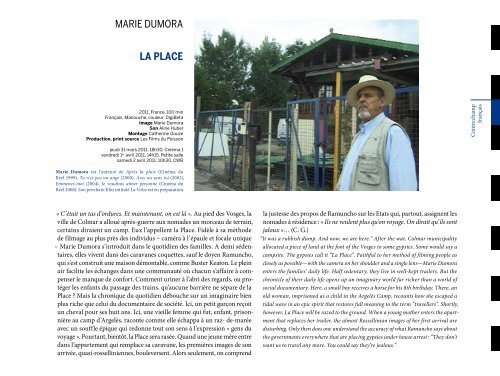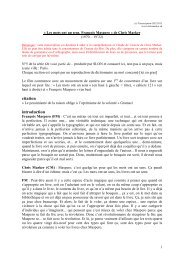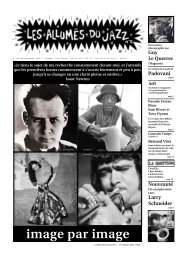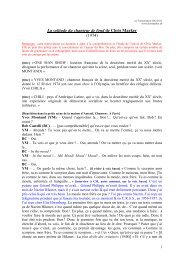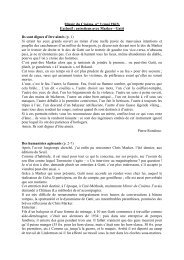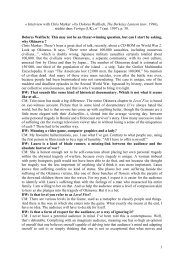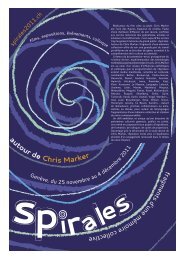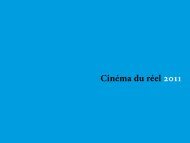Alice DiopLa Mort de Danton5657<strong>2011</strong>, France, 64 minFrançais, couleur, DigiBetaImage Blaise HarrisonSon Pascale MonsMontage Amrita DavidPro<strong>du</strong>ction, print source .Mille et Une. Filmsvendredi 25 mars <strong>2011</strong>, 21h00, Cinéma 1lundi 28 mars <strong>2011</strong>, 14h00, Petite sallemercredi 30 mars <strong>2011</strong>, 10h30, CWBAprès des études d’histoire africaine puis de réalisation documentaire,Alice Diop réalise des magazines et des documentairespour la télévision dont Le Tour <strong>du</strong> monde (2006), Clichy pourl’exemple (2006), Les Sénégalaises et la Sénégauloise (2007).Steve apprend le métier d’acteur au prestigieux cours Simon, à Paris. Son rôle idéal ?Gérard Depardieu dans Danton. Mais « le prof ne veut me donner de rôle que quandil y a un noir dans la pièce ! ». Alice Diop filme, plusieurs mois <strong>du</strong>rant, un momentcharnièrede la vie de cet acteur débutant : comment avouer à sa bande de copainsde la cité des 3000 d’Aulnay-sous-Bois que, depuis trois ans, il débourse trois centseuros par mois pour apprendre à jouer ? Comment parler aux jeunes filles parisiennes<strong>du</strong> cours sans « leur faire peur » ? Comment faire que son prof de théâtre, quil’exhorte dans son bureau à ne pas « rester en bor<strong>du</strong>re », lui confie des compositionsplus fournies que pour Miss Daisy et son chauffeur ? Un dialogue avec une cinéasteque l’on sent proche de celui qu’elle filme s’engage à l’occasion de moments deremise en question, de doutes. Par des questions ou des conseils, Alice Diop sembleaider Steve à tenir la rampe, au sens théâtral bien sûr, à ne pas abandonner mêmequand il ne se sent pas à sa place. En alternant les transformations de l’acteur enpersonnage de scène et les transformations involontaires d’un Steve déprimé au pirede sa forme, La Mort de Danton montre combien le désir d’un indivi<strong>du</strong> est sanscesse menacé de submersion. Mais ce récit d’une initiation difficile peut aussi êtrevu comme un tout autre portrait, moins jeune et moins prometteur que le talent deSteve : le portrait d’une France qui refuse toujours de voir un Danton noir. (C. G.)Steve is learning to be an actor at the prestigious Cours Simon in Paris. His ideal part ? GérardDepardieu in Danton. But “the teacher only wants to give me a part when there is a Black inthe play!” Over several months Alice Diop films a turning-point in the life of this novice actor :how can he admit to his band of mates in the “City of 3000” at Aulnay-sous-Bois that for threeyears he has been spending three hundred Euros a month to learn how to act ? How can hespeak to the young Parisian girls on his course without “frightening them” ? How can he get hisdrama teacher, who in his office urges him not to “stay on the sidelines”, to give him more challengingroles than in Driving Miss Daisy ? The filmmaker, who is clearly close to the person shefilms, starts up a dialogue with him at the point when questionings and doubts arise. Throughquestions and advice, Alice Diop seems to help Steve to hold on, to not give up even when hefeels that he does not belong there. By alternating the actor’s transformations as a characterand the involuntary transformations of a depressed Steve in bad shape, The Death of Dantonshows to what extent an indivi<strong>du</strong>al’s desire is continuously threatened with submersion. Butthis story of a difficult initiation can also be seen as a very different portrait, not as young orpromising as Steve’s talent : the portrait of a France that still refuses to accept a black Danton.
Marie DumoraLa Place<strong>2011</strong>, France, 100 minFrançais, Manouche, couleur, DigiBetaImage Marie DumoraSon Aline HuberMontage Catherine GouzePro<strong>du</strong>ction, print source Les Films <strong>du</strong> PoissonContrechampfrançaisjeudi 31 mars <strong>2011</strong>, 18h30, Cinéma 1vendredi 1 er avril <strong>2011</strong>, 14h15, Petite sallesamedi 2 avril <strong>2011</strong>, 10h30, CWBMarie Dumora est l’auteure de Après la pluie (Cinéma <strong>du</strong>Réel 1999), Tu n’es pas un ange (2000), Avec ou sans toi (2002),Emmenez-moi (2004), Je voudrais aimer personne (Cinéma <strong>du</strong>Réel 2008). Son prochain film intitulé La Valse est en préparation.« C’ était un tas d’or<strong>du</strong>res. Et maintenant, on est là ». Au pied des Vosges, laville de Colmar a alloué après-guerre aux nomades un morceau de terrain,certains diraient un camp. Eux l’appellent la Place. Fidèle à sa méthodede filmage au plus près des indivi<strong>du</strong>s – caméra à l’épaule et focale unique– Marie Dumora s’intro<strong>du</strong>it dans le quotidien des familles. A demi sédentaires,elles vivent dans des caravanes coquettes, sauf le doyen Ramuncho,qui s’est construit une maison démontable, comme Buster Keaton. Le pleinair facilite les échanges dans une communauté où chacun s’affaire à compenserle manque de confort. Comment uriner à l’abri des regards, ou protégerles enfants <strong>du</strong> passage des trains, qu’aucune barrière ne sépare de laPlace ? Mais la chronique <strong>du</strong> quotidien débouche sur un imaginaire bienplus riche que celui <strong>du</strong> documentaire de société. Ici, un petit garçon reçoitun cheval pour ses huit ans. Ici, une vieille femme qui fut, enfant, prisonnièreau camp d’Argelès, raconte comme elle échappa à un raz- de-maréeavec un souffle épique qui redonne tout son sens à l’expression « gens <strong>du</strong>voyage ». Pourtant, bientôt, la Place sera rasée. Quand une jeune mère entredans l’appartement qui remplace sa caravane, les premières images de sonarrivée, quasi-rosselliniennes, bouleversent. Alors seulement, on comprendla justesse des propos de Ramuncho sur les Etats qui, partout, assignent lesnomades à résidence : « Ils ne veulent plus qu’on voyage. On dirait qu’ils sontjaloux »… (C. G.)“It was a rubbish <strong>du</strong>mp. And now, we are here.” After the war, Colmar municipalityallocated a piece of land at the foot of the Vosges to some gypsies. Some would say acampsite. The gypsies call it “La Place”. Faithful to her method of filming people asclosely as possible—with the camera on her shoulder and a single lens—Marie Dumoraenters the families’ daily life. Half sedentary, they live in well-kept trailers. But thechronicle of their daily life opens up an imaginary world far richer than a world ofsocial documentary. Here, a small boy receives a horse for his 8th birthday. There, anold woman, imprisoned as a child in the Argelès Camp, recounts how she escaped atidal wave in an epic spirit that restores full meaning to the term “travellers”. Shortly,however, La Place will be razed to the ground. When a young mother enters the apartmentthat replaces her trailer, the almost Rossellinian images of her first arrival aredisturbing. Only then does one understand the accuracy of what Ramuncho says aboutthe governments everywhere that are placing gypsies under house arrest : “They don’twant us to travel any more. You could say they’re jealous.”
- Page 3 and 4:
Cinéma du réelremercie toutpartic
- Page 5 and 6: Patrick BazinDirecteur de la BpiBib
- Page 7 and 8: Guy SeligmannPrésident de laScamSo
- Page 9 and 10: Claude LemeslePrésident duConseild
- Page 13 and 14: Autres jurys13Le Jury des jeunes, c
- Page 15 and 16: Compétition internationaleCompéti
- Page 17 and 18: Ruth BeckermannAmerican Passages17C
- Page 19 and 20: Claudio PazienzaExercices de dispar
- Page 21: Lee Anne SchmittThe Last Buffalo Hu
- Page 24: 2425Ariane DoubletLa Pluie et le be
- Page 30: 3031Olga MaurinaDomHome2011, Russie
- Page 33 and 34: Bettina BüttnerKinderKids2011, All
- Page 35 and 36: Filipa ReisJoão Miller GuerraNuno
- Page 37 and 38: Marco SantarelliScuolaMediaJunior H
- Page 39 and 40: Michele PennettaI Cani abbaianoThe
- Page 41 and 42: juan Manuel SepúlvedaExtraño rumo
- Page 43 and 44: Javier LoarteMe llamoRoberto Delgad
- Page 45 and 46: Vania AillonLa Terre tremble2011, S
- Page 47: Mehdi BenallalAux rêveurstous les
- Page 50 and 51: Matthieu ChatellierDoux amer5051201
- Page 53 and 54: Gaël LépingleJulien2010, France,
- Page 55: Sophie BruneauMarc-Antoine RoudilMa
- Page 60: News From…Patrick KeillerNicolás
- Page 63 and 64: Verena Paravel, J.P. Sniadeckisamed
- Page 65 and 66: 2010, Chine, 356 minMandarin, coule
- Page 67 and 68: Séancesspéciales10. Mythologie ou
- Page 69 and 70: Andrei Ujică,La révolution, live1
- Page 71 and 72: 2010, Roumanie, 180 minRoumain, cou
- Page 73 and 74: 1993, États-Unis /Italie, 55 minHi
- Page 75 and 76: Leo HurwitzAmerica never was Americ
- Page 77 and 78: Leo Hurwitz #1samedi 26 mars 2011,
- Page 79 and 80: Leo Hurwitz #3jeudi 31 mars 2011, 1
- Page 81 and 82: Richard LeacockRichard Leacock aura
- Page 83 and 84: Dédicace Richard Leacocksamedi 2 a
- Page 85 and 86: Les outils du cinéma documentaire
- Page 87 and 88: Camera #3 Pierre Lhomme, Renato Ber
- Page 89 and 90: Dédicaces& Ateliers
- Page 91 and 92: Le poème documentaireLe 28 octobre
- Page 93 and 94: Exploring documentary #2 Rudy Burck
- Page 96 and 97: Exploring documentary # 5 Helga Fan
- Page 98 and 99: Exploring documentary #7 Leighton P
- Page 100 and 101: Exploring documentary #9 Odes ciné
- Page 103 and 104: 1994 et 2001, France, 8 minFrançai
- Page 105 and 106: Thanks for the American dream,To vu
- Page 107 and 108:
1931, États-Unis, 11 minCartons an
- Page 109 and 110:
1935, États-Unis, 6 minCartons ang
- Page 112 and 113:
Réalisateur inconnuProtestExtrait
- Page 116 and 117:
Écoute Voir !Hors scèneAvec le so
- Page 118 and 119:
Hors scène #2jeudi 31 mars 2011, 1
- Page 120:
Hors scène #5samedi 2 avril 2011,
- Page 123 and 124:
Hors scène #10dimanche 3 avril 201
- Page 125 and 126:
Lech Kowalski : Underground Rock St
- Page 127 and 128:
Le cinéma est parfois invisible.Ce
- Page 129 and 130:
Adriano Aprà Historien du cinéma,
- Page 131 and 132:
Était-ce un téléfilm ? Un oubli
- Page 133 and 134:
¹de connaître les films du Hollan
- Page 135 and 136:
Freddy BuacheAncien conservateur de
- Page 137 and 138:
¹Vincent Dieutre CinéasteLe film
- Page 139 and 140:
¹c’était une manière de miracl
- Page 141 and 142:
Mon film et l’entretien ont été
- Page 143 and 144:
¹au paysage urbain de New York, le
- Page 145 and 146:
¹Eric Le Roy Chef du service Accè
- Page 147 and 148:
¹Marcel Lozinski CinéasteA la rec
- Page 149 and 150:
¹surgissent quand on les a cherch
- Page 151 and 152:
¹contenu réaliste, voire ethnogra
- Page 153 and 154:
¹Errere errera…Je suis en voyage
- Page 155 and 156:
¹teur, je suis presque sûr que se
- Page 158 and 159:
158159Peter von Bagh Cinéaste, his
- Page 160 and 161:
Mémoire du réel
- Page 162 and 163:
Les 20 ans du Prix Louis Marcorelle
- Page 164 and 165:
Rencontres et événements
- Page 166 and 167:
Soirée Video et Après / Cinéma d
- Page 168 and 169:
Rencontres et débats168169Rencontr
- Page 170 and 171:
Forum AddocQuand le documentairereg
- Page 172 and 173:
172173Séances hors les mursCENTRE
- Page 174 and 175:
176177Index des réalisateursAAbi S
- Page 176 and 177:
178KGP Kranzelbinder GabrieleProduc
- Page 178:
180181L’ équipe du Cinéma du r


